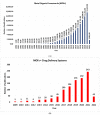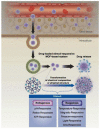Applications of Metal-Organic Frameworks as Drug Delivery Systems
- PMID: 35457275
- PMCID: PMC9026733
- DOI: 10.3390/ijms23084458
Applications of Metal-Organic Frameworks as Drug Delivery Systems
Abstract
In the last decade, metal organic frameworks (MOFs) have shown great prospective as new drug delivery systems (DDSs) due to their unique properties: these materials exhibit fascinating architectures, surfaces, composition, and a rich chemistry of these compounds. The DSSs allow the release of the active pharmaceutical ingredient to accomplish a desired therapeutic response. Over the past few decades, there has been exponential growth of many new classes of coordination polymers, and MOFs have gained popularity over other identified systems due to their higher biocompatibility and versatile loading capabilities. This review presents and assesses the most recent research, findings, and challenges associated with the use of MOFs as DDSs. Among the most commonly used MOFs for investigated-purpose MOFs, coordination polymers and metal complexes based on synthetic and natural polymers, are well known. Specific attention is given to the stimuli- and multistimuli-responsive MOFs-based DDSs. Of great interest in the COVID-19 pandemic is the use of MOFs for combination therapy and multimodal systems.
Keywords: drug delivery systems; encapsulation; metal organic frameworks; stimulus; surface modification.
Conflict of interest statement
The authors declare no conflict of interest.
Figures






Similar articles
-
Recent Advances in Metal-Organic Frameworks as Anticancer Drug Delivery Systems: A Review.Anticancer Agents Med Chem. 2021;21(18):2487-2504. doi: 10.2174/1871520621666210119093844. Anticancer Agents Med Chem. 2021. PMID: 33463479 Review.
-
Recent advances in metallopolymer-based drug delivery systems.RSC Adv. 2019 Nov 13;9(63):37009-37051. doi: 10.1039/c9ra06678k. eCollection 2019 Nov 11. RSC Adv. 2019. PMID: 35539076 Free PMC article. Review.
-
Advances and Applications of Metal-Organic Framework Nanomaterials as Oral Delivery Carriers: A Review.Mini Rev Med Chem. 2022;22(20):2564-2580. doi: 10.2174/1389557522666220330152145. Mini Rev Med Chem. 2022. PMID: 35362373 Review.
-
Stimuli-Responsive Design of Metal-Organic Frameworks for Cancer Theranostics: Current Challenges and Future Perspective.ACS Biomater Sci Eng. 2023 Aug 14;9(8):4497-4526. doi: 10.1021/acsbiomaterials.3c00507. Epub 2023 Aug 1. ACS Biomater Sci Eng. 2023. PMID: 37526605 Review.
-
Design of Metal-Organic Frameworks for pH-Responsive Drug Delivery Application.Mini Rev Med Chem. 2019;19(20):1644-1665. doi: 10.2174/1389557519666190722164247. Mini Rev Med Chem. 2019. PMID: 31880236 Review.
Cited by
-
Computational and Experimental Study of Metal-Organic Frameworks (MOFs) as Antimicrobial Agents against Neisseria gonorrhoeae.ACS Appl Mater Interfaces. 2025 Apr 9;17(14):20628-20646. doi: 10.1021/acsami.4c15851. Epub 2025 Mar 27. ACS Appl Mater Interfaces. 2025. PMID: 40145890 Free PMC article.
-
Transdermal Hydrogen Sulfide Delivery Enabled by Open-Metal-Site Metal-Organic Frameworks.J Am Chem Soc. 2024 Jul 17;146(28):18927-18937. doi: 10.1021/jacs.4c00674. Epub 2024 Jul 5. J Am Chem Soc. 2024. PMID: 38968420 Free PMC article.
-
New N4-Donor Ligands as Supramolecular Guests for DNA and RNA: Synthesis, Structural Characterization, In Silico, Spectrophotometric and Antimicrobial Studies.Molecules. 2023 Jan 3;28(1):400. doi: 10.3390/molecules28010400. Molecules. 2023. PMID: 36615615 Free PMC article.
-
Photoresponsive Metal-Organic Frameworks as Adjustable Scaffolds in Reticular Chemistry.Int J Mol Sci. 2022 Jun 27;23(13):7121. doi: 10.3390/ijms23137121. Int J Mol Sci. 2022. PMID: 35806126 Free PMC article. Review.
-
Constructing Physiological Defense Systems against Infectious Disease with Metal-Organic Frameworks: A Review.ACS Appl Bio Mater. 2023 Aug 21;6(8):3052-3065. doi: 10.1021/acsabm.3c00391. Epub 2023 Aug 10. ACS Appl Bio Mater. 2023. PMID: 37560923 Free PMC article. Review.
References
-
- Rahamathulla M., Bhosale R.R., Osmani R.A.M., Mahima C.K., Johnson P.A., Hani U., Ghazwani M., Begum M.Y., Alshehri S., Ghoneim M.M., et al. Carbon nanotubes: Current perspectives on diverse applications in targeted drug delivery and therapies. Materials. 2021;14:6707. doi: 10.3390/ma14216707. - DOI - PMC - PubMed
Publication types
MeSH terms
Substances
LinkOut - more resources
Full Text Sources
Miscellaneous

